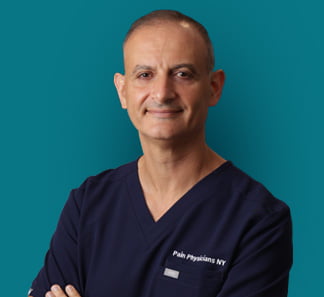With so many different ailments that can cause back pain, you need to have a group of experts you can depend on. The specialists at pain management in New York City deal exclusively with pain issues and have extensive experience treating painful conditions in your spine. Weakened vertebral bones can develop small, but extremely painful compression fractures. Untreated, these fractures can lead to an abnormally curved spinal column that makes you look like you have a hunchback. Thanks to the most up-to-date regenerative treatments offered in Midtown Manhattan, you can find relief with a simple procedure called a kyphoplasty surgery. It’s minimally invasive and can get you back to your normal height while relieving your pain.
One of the most common issues that arises after a spinal fracture is dealing with ongoing back pain. A fracture often puts pressure on certain nearby nerves due to compression or because of the instability of the bones. The goal of a kyphoplasty procedure is to relieve you of your discomfort and stabilize the bones at or around the fracture.
If you’ve experienced recent spinal or compression fractures due to osteoporosis, you’re an ideal candidate for this procedure. While the surgery doesn’t correct an established or chronic deformity, kyphoplasty spine surgery can restore your original height if the procedure is completed within eight weeks of the original fracture. Your best odds of a successfully restorative procedure happens when the back pain experts at pain treatment center NYC are the ones to do it.
Osteoporotic Fractures

If you’ve been diagnosed with osteoporosis, you know you’re at risk for fractures. Osteoporosis makes it difficult or impossible for your body to absorb needed calcium, which is the strengthening agent in your bones.
As your bones lose calcium, the stacked bones of your vertebrae can collapse, especially in the front part of your spinal column. The collapse causes humps and perhaps even shortened height. Serious health conditions that accompany this collapse include:
- Limiting your functionality and mobility due to pain and lack of flexibility
- Decreasing your lung capacity, as your lungs become compressed at the front of your body
- Losing independence and the ability to accomplish everyday tasks
- Reducing your ability to get a good night’s sleep
- Experiencing severe and chronic pain and discomfort
Studies have shown that once you have one osteoporotic spinal fracture, you are five times more likely to have another one due to the pressure placed on the spine and the continued loss of calcium. If you’ve been diagnosed with osteoporosis, you have a lifetime of careful choices ahead of you. The disease can be controlled, but not cured.
What Happens During Kyphoplasty Spine Surgery?
After a thorough examination, including a complete review of any previous procedures you’ve undergone, your pain specialist in New York performs diagnostic tests using the most advanced diagnostic equipment available. When it’s been confirmed that you indeed have compression fractures and reduced bone density, you first may undergo more conservative back treatments.
If those don’t give you sufficient relief, your doctor may offer to relieve your pain with a minimally invasive surgery called a kyphoplasty. The kyphoplasty procedure is performed under local or general anesthesia and takes about an hour. It requires a number of steps, including:
- The procedure begins with a small incision in your back at the site of the original fracture.
- Using fluoroscopy x-rays to guide a narrow tube, your Manhattan back pain doctor reaches the area of your spine where the bone has been damaged.
- Guiding his instruments through the tube to the correct space between the compressed vertebrae, the doctor is ready to begin.
- He inserts a small balloon through the tube and carefully inflates it. This elevates the fractured bone and returns it to its original position. The goal is to create a cavity within the vertebrae. This cavity restores the original height to your bone and reduce any deformities in your spine.
- After removing the balloon, your doctor uses specialized instruments under low pressure to fill the cavity with a pasty substance called polymethylmethacrylate (PMMA) that quickly hardens to stabilize the bone. This also restores your original height.
- You may spend a day in the hospital under observation, although many go home the same day.
Recovery from Kyphoplasty Surgery
You may have some slight discomfort because of the incision. Most patients, however, report relief from the pain of a spinal fracture within a couple of days. Although you can resume normal activities within a few days, don’t lift anything heavy for up to six weeks to allow for full healing of not only the surgical site, but of the fracture as well.
When you rely on the best-in-class physicians at Pain Management NYC, your risk of having any side effects decreases significantly. You need to know, however, that this surgery doesn’t prevent other fractures that may occur due to the weakening of your bones through osteoporosis. Ask your doctor how best to control your osteoporosis symptoms.
As a minimally invasive procedure, your recovery prognosis is much quicker and less painful than open surgeries done in the past. By restoring your height and stabilizing the weakened bone, kyphoplasty procedures effectively strengthen compromised systems, reducing your pain, improving your lung capacity, providing greater mobility and enabling a better night’s sleep. Contact us to schedule an initial examination.

Boleslav Kosharskyy, MD, is a top-rated, best-in-class interventional pain management doctor. He is board-certified in Anesthesiology, Interventional Pain Medicine, and Palliative Care.
Dr. Kosharskyy is an Associate Professor of Anesthesiology and Rehabilitation Medicine at Albert Einstein Medical College. He’s also the Associate Medical Director of Pain Medicine and Director of Anesthesia for the Joint Replacement Center at Montefiore Medical Center and Albert Einstein Medical College.
He is an active member of the American Society of Anesthesiology (ASA), the American Society of Regional Anesthesia and Pain Medicine (ASRA), and the New York State Society of Anesthesiologists (NYSSA)
